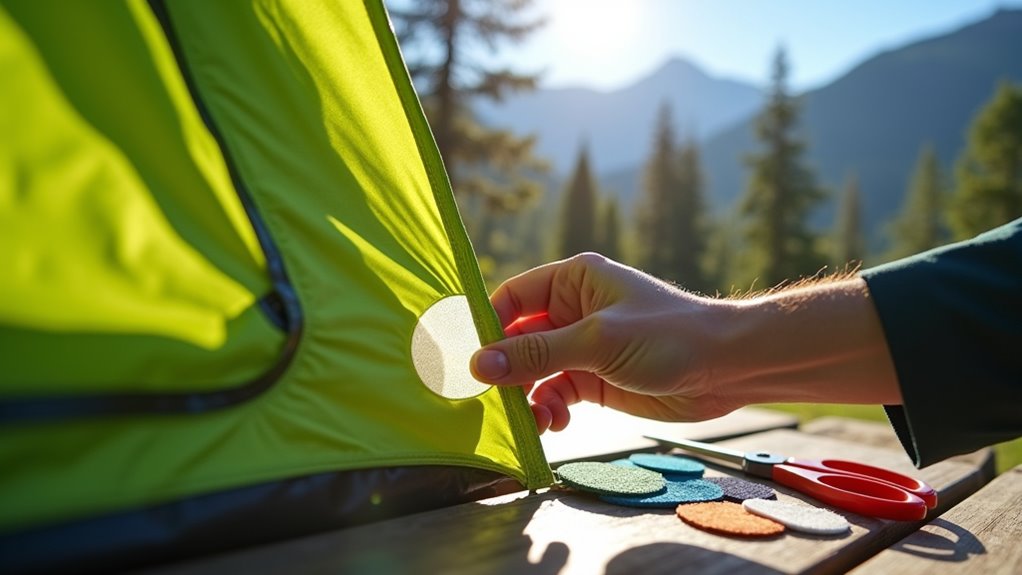How To Fix Ripped Tent
This post contains affiliate links. As an Amazon Associate, we earn from qualifying purchases.
To fix a ripped tent, clean the damaged area, trim loose threads, and apply a suitable patch with waterproof glue. This basic process effectively seals tears and restores your tent’s durability. Further down, you’ll find detailed steps and additional tips for repairing seams and unraveled edges to ensure a long-lasting fix.
Essential Facts in 30 Seconds
- Clean the torn area before repairs to remove dirt and oils.
- Use patch material that matches the tent fabric for best results.
- Apply waterproof glue and press patches firmly to avoid air bubbles.
- Use seam sealant and patches to fix and reinforce seam rips.
- Let patches or sealant cure 6 to 24 hours before packing the tent.
Cleaning and Preparing the Area for Repair

Start by cleaning the torn area carefully. Use rubbing alcohol or mild soap to remove dirt and oils. Dirt stops patches from sticking well. Use a clean cloth to wipe gently around the rip. Avoid strong chemicals; they can harm the tent fabric. Regular maintenance can help prevent zipper issues that could lead to rips.
Lay the tent flat on a dry, clean surface next. This stops extra strain on the tear. Cut loose threads with scissors. Brush off dust and dirt from both sides. Smooth wrinkles near the rip so the patch fits well. Additionally, make sure to clean the tent thoroughly before applying any patches, as proper cleaning helps ensure better adhesion.
If outside, pick a dry, sheltered spot to work. Good cleaning and prep help patches last longer.
Choosing the Right Repair Materials
Select repair materials that match your tent’s fabric and conditions.
Nylon tents need vinyl cement for a strong, waterproof bond. Avoid contact cement because it reacts poorly with nylon. Additionally, timely damage assessment is crucial to determine the extent of repairs needed before choosing materials.
Silicone-coated tents require special adhesives made for silicone surfaces to stick well.
Polyurethane fabrics need repair materials that keep waterproofing without peeling.
Choose patches that stay waterproof, flexible, and resist UV rays.
Always pick materials that fit your tent’s needs. This ensures a repair that lasts and stands up to weather. Additionally, regularly inspect zippers for any visible dirt or debris often gets lodged to maintain their functionality.
Effective Patching Techniques

Selecting the right materials makes your tent patch strong and long-lasting. Use patches made for outdoor fabrics and waterproof glue. Gathering repair materials is crucial for a successful repair.
Clean the damaged area well before applying any patch. Press the patch firmly to stick it tight. Let it dry completely to avoid peeling. Reinforcement techniques can further enhance the durability of your repair.
Fixing tears and holes this way keeps your tent safe from rain and wind. A good patch can save your tent and help it last many camping trips.
Follow these steps carefully for the best results.
Choosing Repair Materials
To repair your tent well, pick the right materials. Match the material to your tent fabric type. Use strong, lasting products that work well outdoors. Here is a simple guide:
| Repair Material | Best For | Key Features |
|---|---|---|
| Tenacious Tape™ | Fabric and mesh panels | Fast, strong repair |
| HH-66 Vinyl Cement | Vinyl laminated fabrics | Heat-safe, tough bond |
| Tear Mender adhesive | Fabric and leather | Waterproof, protects from sun |
| Silicone-based seam grip | Seams | Waterproof, holds tight |
| Gear tape | Quick fixes in the field | Easy to apply, cures in 24 hours |
Use patches that cover the tear plus ½ to 1 inch extra on all sides. This size keeps the patch stuck well and stops the tear from growing. Good repairs keep your tent safe and dry on every trip, so ensure you gather repair materials beforehand to avoid delays in fixing the issue. Additionally, ensure that the tent is completely dry before applying any patches to prevent further issues with mold or damage.
Applying Patches Correctly
Preparing your tent surface helps the patch stick better. Clean the area well using rubbing alcohol. This removes dirt and oils that block glue. Make sure the fabric is dry before putting the patch on. Wet fabric stops the patch from sticking right.
Cut the patch bigger than the tear. Add one inch extra and round the corners. This stops the patch from peeling off. Lay the tent flat on a surface. Peel back some patch backing to line it up exactly. Press down hard to push out air bubbles. Rub the edges to make the patch strong.
Use two patches on spots that get a lot of stress. Put one patch inside and one outside to hold better. This method helps your tent stay fixed longer. Additionally, assessing the damage before patching ensures you choose the appropriate patch size and technique.
Ensuring Strong Adhesion
Strong adhesion is key for fixing a tent well. Small mistakes can cause patches to fail. Follow these steps for the best results:
- Clean the torn area using rubbing alcohol. This removes dirt and oils.
- Pick the right glue. Use PU glue for inside patches. Use silicone glue for outside patches.
- Cut patches bigger than the tear by at least one inch. Round the corners to stop peeling.
- Push the patch firmly from the center outwards. Make sure no air bubbles stay trapped.
Doing these steps right keeps your tent strong and dry.
Addressing Seam Rips and Unraveling

Sure! Here’s the revised content following your directions:
—
Seam rips and loose threads can damage your tent quickly. Fix these problems fast to keep your tent strong. Clean the seam area with mild soap and water. Remove dirt and oils well. Use a seam sealant that works with your tent fabric. Spread it evenly along the seams. Cut loose threads carefully. Use patching or seam reinforcement to stop more damage. Regular seam sealing can prolong your tent’s lifespan and improve your camping experience.
Quick repair guide:
| Action | Materials Needed | Tips |
|---|---|---|
| Clean seams | Mild soap, sponge | Wipe 3/4 inch beyond the tear |
| Apply sealant | Compatible sealant | Smooth out air bubbles |
| Patch rips | Tenacious Tape | Round corners to avoid peeling |
| Trim loose threads | Scissors | Cut before sealing |
Ensuring Proper Drying and Curing Time
Fixing seam rips and loose threads is just the start. Drying and curing your repairs properly keeps them strong.
First, clean the area well with rubbing alcohol or mild soap. Let it dry fully.
Next, spread the right glue or sealant evenly on the fabric. Use a product made for your tent’s material.
Set the tent standing or flat in a place with good air flow. Keep the temperature and humidity moderate.
Let it cure for 6 to 24 hours before packing. Taking your time here stops repairs from failing later.
Good drying and curing make your tent last longer. Patience pays off.
Additional Tips for Successful Repairs

Repair your tent with care for long-lasting results. Use repair kits made for tents, like Tenacious Tape™ or Seam Grip. Avoid household tape; it leaves sticky residue.
Clean the torn area well using rubbing alcohol or mild soap. This helps patches stick better. Large tears need sewing first. Use a sewing awl and waxed thread for strong seams.
Cut patch corners round to stop peeling. Check your tent after repairs for new tears. Strengthen busy areas like corners often. Seal new seams with extra waterproofing.
These steps help your tent last longer and stay strong.
Frequently Asked Questions
Can I Use Regular Tape for Tent Repairs?
Regular tape can fix a tent for a short time. It does not hold well in rain or wind. Tents need special tape made for outdoor use. This tape sticks better and lasts longer. Using the right tape can save your tent from bigger damage. Strong, weatherproof tape keeps your tent safe and dry. Choose tape designed for tents to get the best results.
How Do I Prevent Future Rips in My Tent?
Prevent rips in your tent by taking good care of it. Always use a ground tarp under your tent. This protects the bottom from sharp rocks and sticks. Check your tent often for small holes or weak spots. Fix these quickly to stop bigger tears. Handle zippers, poles, and fabric gently. Keep knives, scissors, and other sharp tools away from the tent. Clean your tent after every trip to avoid dirt buildup. Store it in a dry place to prevent mold and damage. These simple steps make your tent last longer and stay strong.
What Should I Do if My Tent Is Leaking?
Check seams and fabric for holes or weak spots. Use tape or sealant to fix small leaks right away. Apply waterproof spray to protect your tent next time. Keep your tent dry and clean to stop leaks from getting worse. A strong tent keeps you safe and dry during rain.
Is It Safe to Use a Tent After Repairing It?
Using a tent after repairing it is safe. Use strong patches and waterproof glue for repairs. Check the fixed spots before each trip to ensure they hold well. Small tears or holes can be sealed easily with repair tape. Proper repairs keep the tent dry and sturdy. Regular care helps the tent last many camping seasons. Always carry a repair kit to fix problems fast. This way, your tent stays safe and ready for outdoor fun.
How Often Should I Inspect My Tent for Damage?
Check your tent for damage at least twice a year. This helps stop leaks and tears before camping trips. Look for holes, broken zippers, or loose seams. Bad weather can cause unseen damage. Fix small problems early to avoid bigger ones later. Regular checks keep your tent strong and dry. Safe camping starts with a well-maintained tent.
Conclusion
Fixing your tent means you can enjoy the outdoors again. Imagine the sun shining through trees while you set up your patched tent. Your shelter now keeps out wind and rain. Fix small rips quickly to avoid bigger tears. Keep a repair kit with you on every trip. Check your tent often for holes or weak spots. Taking care of your tent helps it last longer. This way, many fun camping trips lie ahead. Stay ready, act fast, and enjoy nature safely.
